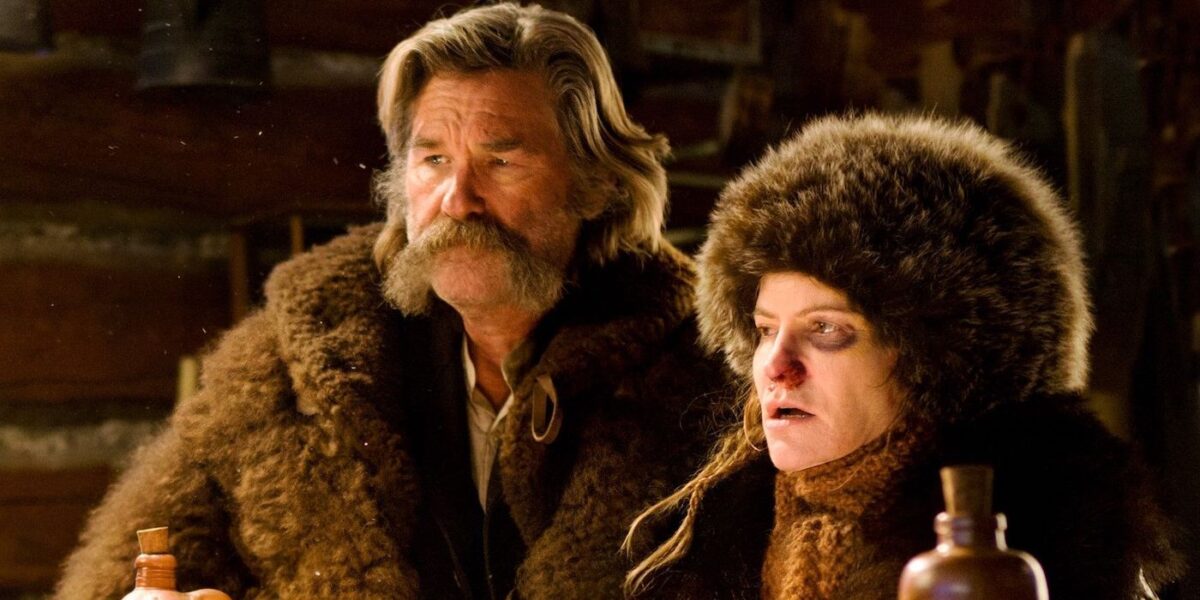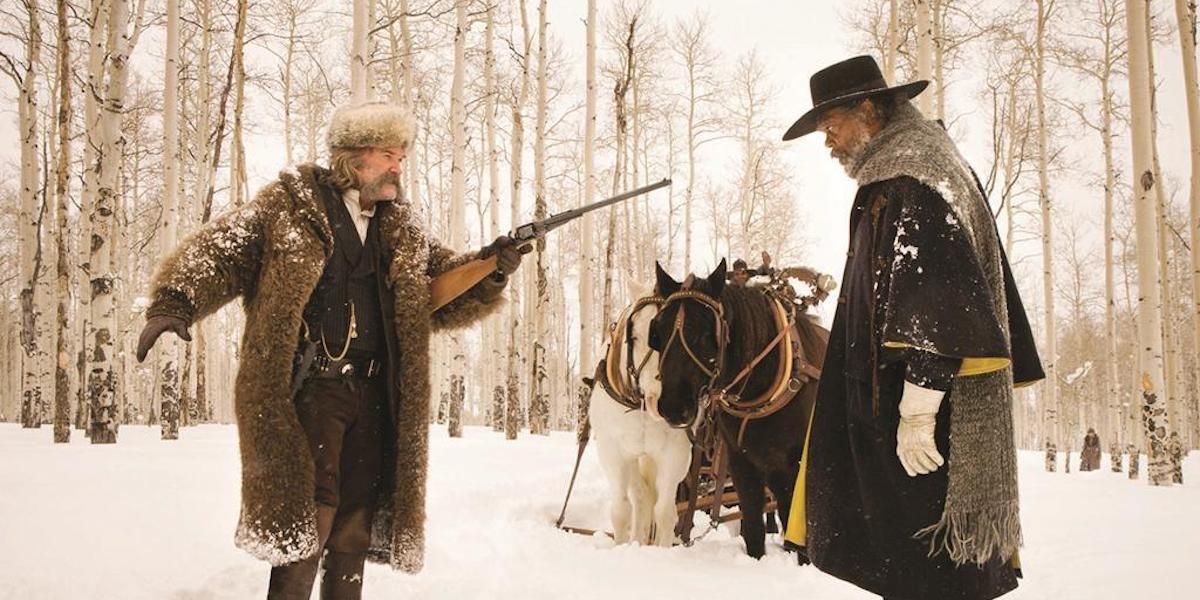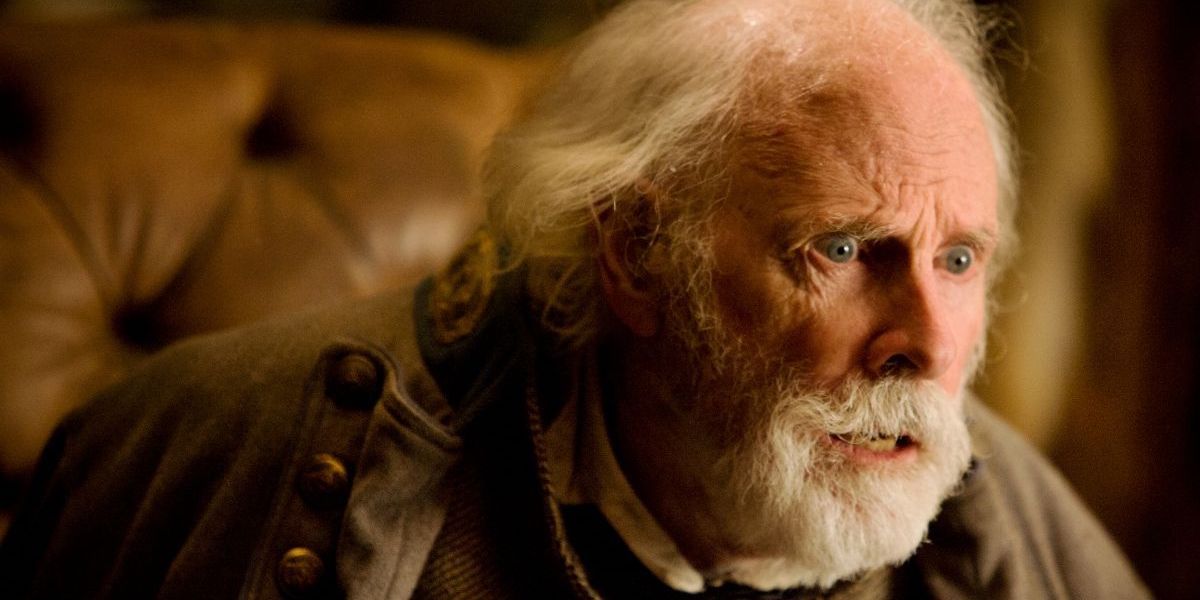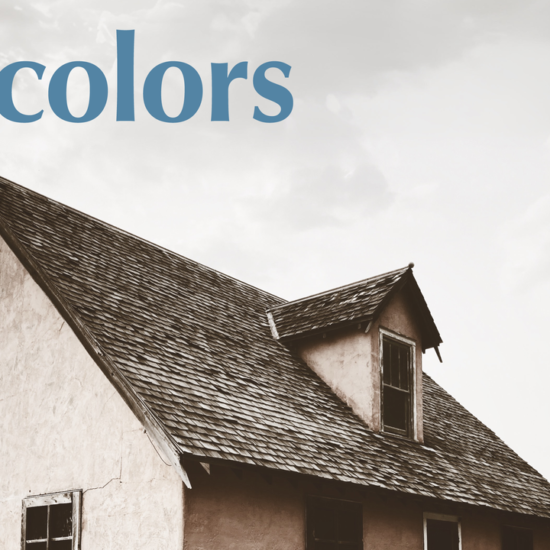
The Hateful Eight Extended Version — the miniseries recut from Quentin Tarantino‘s original 2015 film — is back on Netflix this week. As Tarantino told SlashFilm shortly after the series’ initial release in April 2019, the project came about when Netflix approached him directly, wanting to know if there was even more footage available beyond the 70 mm roadshow cut and whether it could be reworked into a short series. So the director, alongside the film’s original editor Fred Raskin, got to work, recutting the film into four episodes of about 50 minutes each, which streamed until January of this year. In honor of its re-release, let’s explore: how different is it from the original, and is it worth watching?
The 2015 film was long at about 168 minutes and was divided into six chapters, each with its own title card. The miniseries clocks in at 210 minutes — but that doesn’t add up to as much new footage as you might think based on the math. Fans of the movie might remember the lengthy, beautifully cinematic (even for Tarantino) opening credits sequence, which features a lingering shot of a snowy Wyoming landscape set against Ennio Morricone’s haunting score. Each episode of the miniseries includes both that opening credits sequence and the closing credits, and the second, third, and fourth episodes also include a brief replay of the final scene of the previous episode. Combined, this inflates the runtime of each episode by about eight minutes. The original film without the credits is about 160 minutes; the extended version without the credits is about 178, meaning there’s only around 18 minutes of new footage.
The miniseries’ episodes share their titles with the film’s chapters, though there are fewer of them. The new footage shows up mainly in slightly extended dialogue sequences — there are no changes to the plot, story structure, or timeline. However, there are some scene extensions that give us a few interesting moments between the players and a bit more insight into their characters.
‘The Hateful Eight: Extended Version’s First Episode Has Few Changes
Episode 1, “Last Stage to Red Rock,” is the shortest of the series and features the fewest changes from the original. Major Marquis Warren (Samuel L. Jackson) and O.B. (James Parks) haggle a bit more over the particulars of getting Warren’s bounties strapped to the top of the coach, and in the same scene, we’re treated to a shot of John Ruth (Kurt Russell) peeing against its side. The dialogue inside the coach is also slightly more substantial: John hurls more abuse at Daisy (Jennifer Jason Leigh), and John and the Major chat a bit more. After Warren expresses his disappointment at having to put down his horse Lash, whom he might have considered his best friend if he considered stupid animals to be friends — which he doesn’t — John shares that he had a horse named Cauliflower that he affectionately called his “beast friend.”
Kurt Russell’s John Ruth Is a Mean Bastard
Episode 2, “Minnie’s Haberdashery,” starts in the same moment as the film chapter of the same name: the coach’s arrival at the eponymous haberdashery. The episode shows us more footage of Warren, O.B., Chris Mannix (Walton Goggins), and Bob (Demián Bichir) trudging through the rapidly deepening snow to put the horses in the stable and extends the scene in which Mannix and Confederate General Sanford Smithers (Bruce Dern) meet, with Mannix offering a toast of brandy to Smithers’ deceased son, service, and home state of Georgia. Another mini-scene is added in which John, while chowing down on a can of peaches, spots the half-plucked chicken lying on the piano bench — which we later learn was left there because the Domingre Gang shot the plucker — and forces Bob to finish plucking it, saying a half-plucked chicken is bad luck. (He must have been right.) After taking Joe Gage’s (Michael Madsen) and Oswaldo Mobray’s (Tim Roth) guns, John spends a bit more time bossing everyone around, giving them exact instructions as to where to sit, and he smashes a shotgun that was stashed on the wall. The added minutes characterize John as even more paranoid and hostile than he was previously.
Why Can’t Smithers Eat in His Chair?
Episode 3, “Domergue’s Got a Secret,” opens on O.B. dumping the confiscated guns in the outhouse, followed by an argument between Mannix and General Smithers in which Smithers refuses to sit at the table with Major Warren, and Mannix for some reason believes this means Smithers can’t eat any stew — perhaps lending new significance to Warren’s seemingly courteous act of taking a bowl to the General’s chair later. The argument continues in the background for some time as the rest of the crew eats, and we see the Major pray over his food. The rest of the episode proceeds as the film does: John’s delightful observation on the necessity of hanging mean bastards, the reveal of the Lincoln letter’s fraudulence, Warren’s vivid description of his torture of Smithers’ son and his subsequent shooting of Smithers himself, and of course, the poisoning of the coffee and its bloody aftermath.
‘The Hateful Eight: Extended Version’ Gives Us a Glimpse Into the Gang’s Perspective
Episode 4, “The Last Chapter,” contains perhaps the most interesting addition, one which Tarantino was particularly excited to share with an audience in the same SlashFilm interview. Like the film’s fifth chapter, “The Four Passengers,” it begins with a jump back in time to the Domingre Gang’s arrival at the haberdashery and their dispassionate murder of its occupants. But where the film cuts from the moment of John and Daisy’s arrival back to the present, the miniseries shows us their first few minutes in the haberdashery — this time from the gang’s perspective. As John makes coffee, we see Oswaldo/English Pete motion Daisy out of the way so that Joe Gage/Grouch Douglass can take a shot at her captor, and we learn that Daisy wasn’t just mentioning Mannix and Warren’s presence in the stable to make casual conversation — she was warning her gangmates that they weren’t alone. We also get Joe’s reaction to John’s abuse of Daisy: he takes it personally, telling us that this gang is truly devoted to her. The episode then jumps back to the present where Mannix and Warren, on the verge of bleeding to death themselves, dispatch the remaining members of the gang one by one.
So, is the miniseries worth watching? In short, yes. Tarantino fans can appreciate it knowing that it’s the vision of the director himself, and those who liked the original film might enjoy the extra footage as they would any bonus footage or deleted scenes from a good movie. Filmmaking connoisseurs might also note that watching it back-to-back with the original (also currently streaming on Netflix) is a fascinating insight into the nuances and challenges of editing and a commentary on how seemingly minor cuts can change the tone or pacing of a scene dramatically. Lastly, those who have never seen the lengthy original might simply find the fifty-minute blocks of the series more convenient to watch: after all, you can always skip the credits.
















